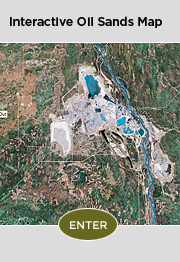About the Oil Sands
Composition
Oil sands are deposits of bitumen, thick, heavy black oil that must be upgraded before it can be used by refineries to produce consumer products such as gasoline and diesel fuels.
Alberta’s bitumen deposits are sometimes erroneously referred to as tar sands but the correct terminology for the resource is oil sands. Tar is a refined substance, while the bitumen contained in the oil sands is naturally occurring.
Bitumen will not flow unless heated or diluted with lighter hydrocarbons. At room temperature it resembles cold molasses. Bitumen makes up about 10 to 12 per cent of the weight of the oil sands found in Alberta. The remainder is 80 to 85 per cent mineral matter – like sand and clays - and 4 to 6 per cent water.
Upgraded
Upgrading is the technical process that converts bitumen into a product similar to conventional light crude oil.
Location and size
Canada has the second largest reserves of oil in the world, after Saudi Arabia. Only 13 per cent of the world’s known oil reserves– one in six barrels – is considered freely accessible to international oil companies, and half of this oil is found in the Athabasca oil sands.
The Province of Alberta sits on proven oil reserves of 179 billion barrels, 97 per cent of which are located in the oil sands. Oil sands are found in northern Alberta beneath approximately 140,000 square kilometers of land, an area larger than the Island of Newfoundland or the State of North Carolina. However, only 2.5 per cent of this area houses oil sands located close enough to the surface to be mineable. The bitumen contained in the remainder of the area must be produced using in-situ technologies. In more than 40 years, oil sands mining has disturbed approximately 530 square kilometers of land, or about one hundredth of one per cent of the Canadian boreal forest.
According to the Government of Alberta, there were 91 active oil sands projects in Alberta as of January 2009. Of these, five are mining projects and the rest use various in-situ recovery methods.
There are three deposits of oil sands in Alberta. The largest and most shallow deposit is the Athabasca oil sands area, located near Fort McMurray. The Athabasca is the largest deposit and is the site where all current mining projects are located. The Cold Lake deposit is the second largest and contains only in-situ projects. The Peace River, Wabasca and Buffalo Head Hills deposits have seen slower development due to the technology required to access the resource. This area is known as the Carbonate Triangle and much work is underway to make resource development in this area technologically and economically feasible.
Technology
Only 20 per cent of the oil sands resource is located close enough to the surface to be mined (this resource is concentrated such that 20 per cent of the total bitumen in the oil sands occurs in an area of just 2.5 per cent of the geographic extent of the oil sands). Using truck and shovel technology, the oil sands are transported to a processing facility where hot water and a small amount of caustic soda (i.e. “soap”) are used to separate the bitumen from the sands and clays. Once the bitumen has been recovered, the remaining sands and clays are sent to a tailings pond – often a discontinued mine pit. The tailings are a mixture of water, clay, sand and residual bitumen. In the tailings ponds, the sand and clays settle and the clarified water is recycled back to the processing facility. More than 80 percent of the water used is recycled.
Tailings are strictly regulated by Alberta Environment and the Energy Resources Conservation Board. The ponds are carefully designed with seepage collection and containment systems. The groundwater is monitored to ensure it is not affected.
In-situ production is used to recover deposits that are located more than 75 meters underground. Most in situ bitumen and heavy oil production comes from deposits buried more than 400 meters below the surface of the earth. Cyclic Steam Stimulation (CSS) and Steam-Assisted Gravity Drainage (SAGD) are in situ recovery methods, which include injecting steam through vertical or horizontal wells. The thick bitumen is heated so that it is able to be pumped to the surface through the wells. In-situ operators generally use non-potable or even saline ground water and they recycle 90 per cent of the water they require.
Other technologies being tested such as THAI™ could have commercial application in the future. This new form of in-situ technology uses air instead of water to heat up the bitumen. This technology uses little natural gas and minimal water while producing 50 per cent less greenhouse gas emissions. Similarly, the injection of solvents such as propane, show promise.




















